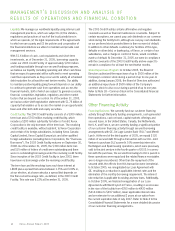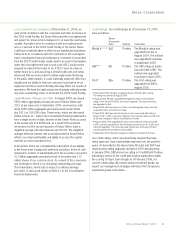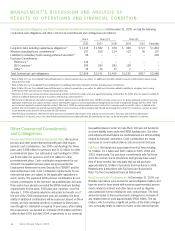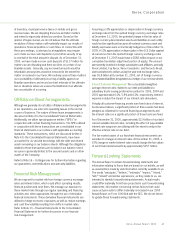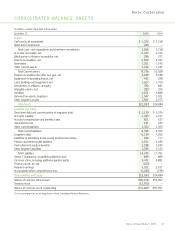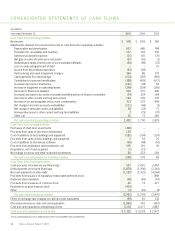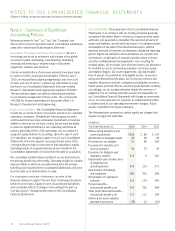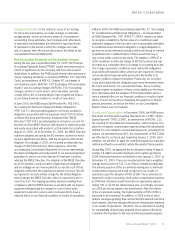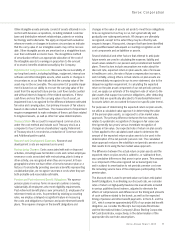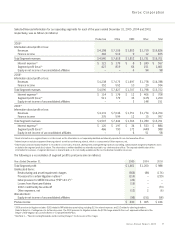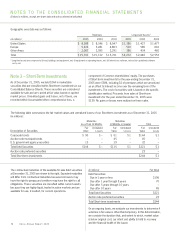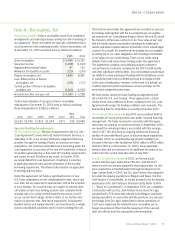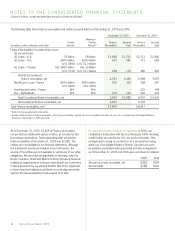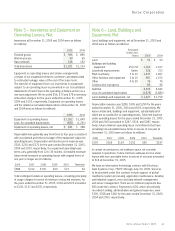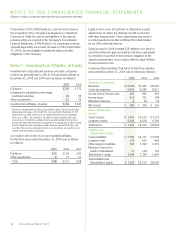Xerox 2005 Annual Report Download - page 60
Download and view the complete annual report
Please find page 60 of the 2005 Xerox annual report below. You can navigate through the pages in the report by either clicking on the pages listed below, or by using the keyword search tool below to find specific information within the annual report.
NOTES TO THE CONSOLIDATED FINANCIAL STATEMENTS
(Dollars in millions, except per-share data and unless otherwise indicated)
52
FAS 123(R) also requires that the benefits of tax deductions
in excess of recognized compensation cost be reported as a
financing cash flow, rather than as an operating cash flow as
required under current literature. This requirement will reduce net
operating cash flows and increase net financing cash flows in
periods after the effective date. While we can not estimate what
those amounts will be in the future (because they depend on,
among other things, when employees exercise stock options),
the amount of operating cash flows recognized in 2005 for such
excess tax deductions was $12.
Pending the effective date of FAS 123(R), we do not recognize
compensation expense relating to employee stock options
because the exercise price is equal to the market price at the
date of grant. If we had elected to recognize compensation
expense using a fair-value approach, and therefore determined
the compensation based on the value as determined by the
modified Black-Scholes option pricing model, our proforma
income and income per share would have been as follows:
(in millions, except per-sharedata) 2005 2004 2003
Net income – as reported $ 978 $ 859 $ 360
Add: Stock-based employee
compensation expense
included in reported net
income, net of tax 25 13 10
Deduct: Total stock-based
employee compensation
expense determined under
fair value based method for
all awards, net of tax (113) (82) (95)
Net income – pro forma $ 890 $ 790 $ 275
Basic EPS – as reported $0.96 $0.94 $0.38
Basic EPS – pro forma 0.87 0.86 0.27
Diluted EPS – as reported $0.94 $0.86 $0.36
Diluted EPS – pro forma 0.85 0.80 0.25
The proforma periodic compensation expense amounts are not
representative of future amounts, as we began granting employees
restricted stock awards with time- and performance-based
restrictions in 2005 in lieu of stock options. As reflected in the
proforma amounts in the previous table, the weighted-average
fair value of options granted in 2004 and 2003 was $8.38 and
$5.39, respectively. The fair values were estimated on the date
of grant using the following weighted average assumptions:
2004 2003
Risk-free interest rate 3.2% 3.3%
Expected life in years(1) 5.7 7.2
Expected price volatility 66.5% 66.2%
Expected dividend yield ––
(1) Options granted in 2004 expireeight years from date of grant, resulting in an
expected life shorter than previous grants.
Refer to Note 18 – Common Stock for additional disclosures
regarding our stock compensation programs.
Summary of Accounting Policies
Revenue Recognition: We generate revenue through the sale and
rental of equipment, service and supplies and income associated
with the financing of our equipment sales. Revenue is recognized
when earned. More specifically, revenue related to sales of our
products and services is recognized as follows:
Equipment: Revenues from the sale of equipment, including those
from sales-type leases, are recognized at the time of sale or at the
inception of the lease, as appropriate. For equipment sales that
require us to install the product at the customer location, revenue is
recognized when the equipment has been delivered to and installed
at the customer location. Sales of customer-installable products are
recognized upon shipment or receipt by the customer according
to the customer’s shipping terms. Revenues from equipment under
other leases and similar arrangements areaccounted for by the
operating lease method and are recognized as earned over the
lease term, which is generally on a straight-line basis.
Service: Service revenues are derived primarily from maintenance
contracts on our equipment sold to customers and are recog-
nized over the term of the contracts. A substantial portion of
our products are sold with full-service maintenance agreements
for which the customer typically pays a base service fee plus a
variable amount based on usage. As a consequence, other than
the product warranty obligations associated with certain of our
low-end products in the Office segment, we do not have any
significant product warranty obligations, including any obligations
under customer satisfaction programs.
Revenues associated with outsourcing services as well as
professional and value-added services are generally recognized
as such services areperformed. In those service arrangements
where final acceptance of a system or solution by the customer
is required, revenue is deferred until all acceptance criteria have
been met. Costs associated with service arrangements are
generally recognized as incurred. Initial direct costs of an arrange-
ment are capitalized and amortized over the contractual service
period. Long-lived assets used in the fulfillment of the arrangements
are capitalized and depreciated over the shorter of their useful
life or the term of the contract. Losses on service arrangements
are recognized in the period that the contractual loss becomes
probable and estimable.
Sales to Distributors and Resellers: We utilize distributors and
resellers to sell certain of our products to end users. We refer
to our distributor and reseller network as our two-tier distribution
model. Sales to distributors and resellers are recognized as
revenue when products are sold to such distributors and
resellers, as long as all requirements for revenue recognition
have been met. Distributors and resellers participate in various
cooperative marketing and other programs, and we record
provisions for these programs as a reduction to revenue when
Xerox Annual Report 2005


